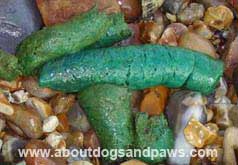I was saddened by news of the death of my dear friend's beloved dog. The fact that the dog was only 5 years old, healthy and happy only makes it more tragic.
When something unexplained happens to your precious dog, it is so hard to deal with and accept. We spend our dog's lives protecting them as they are our children.
It is hard enough to lay them to rest before their time, but even worse when we don't know what took their lives and feel like we should have sheltered them from harm.
When my friend's dog threw up several times as dogs do with an upset stomach, she never could have imagined what was coming next. I have three dogs myself and if I ran to the vet every time someone threw up, I would be spending an enormous amount of time there. Lots of dogs like to chew grass and then they will throw it up, but it doesn't keep them from chewing more.
Within just a couple of days her dog passed away. Only after a necropsy did she find out that it was poison. Because her dog was never loose and lived in house and in a fenced area and she had never used any kind of poison on the premises, she will always question, how was the dog poisoned?
After researching this subject, I found that if caught in time, there is the possibility of saving your precious pet, but timing is very important.
Here are a few of the poisons used to kill rats and how they can affect your dog:
Warfarin Warfarin is becoming increasingly common in rat poisons. A bright green stool could be the first sign of poisoning. The rat poison pellets are often bright green in color. It may be a week before you observe symptoms of poisoning. Poisoning can create symptoms such as bleeding from the nose, gums or rectum, a cough caused by bleeding in the lungs, blood in urine or feces and in the late stages, breathing difficulties.

Bromethalin Fluids accumulate in the brain and also in the membrane surrounding the brain following ingestion of bromethalin. You may see a bright green stool before the other symptoms start. The symptoms can occur anywhere from two days to two weeks after the dog has ingested the poison. Symptoms may include loss of appetite, impaired movement or paralysis and muscle tremors or seizures.
Strychnine Less than two hours after ingesting strychnine a dog will appear to be agitated, excited or apprehensive. Other symptoms include large and painful seizures and possible drooling and muscle spasms. These seizures can last about a minute. During the seizure the dog will turn blue from breathing difficulties. Avoid even the mildest stimulation, such as clapping your hands or tapping the dog as this can set off another seizure.
Sodium Fluroacetate Soon after ingestion the dog will start vomiting. This is followed by the dog straining to urinate or defecate and excitability. The dog will then walk with an unusual gait aimlessly and finally convulsions and collapse.
Phosphorus The smell of garlic on your dog's breath could be the first sign of ingestion. The following symptoms such as vomiting and diarrhea will precede a brief period without symptoms. The dog will then start vomiting again and have pain in the abdomen. Convulsions and then coma will follow.
Zinc Phosphide This chemical depresses the central nervous system. Symptoms can include weakness, breathing difficulties, bloody vomit and convulsions.
The information provided is not intended as medical or veterinary advice. If ever in doubt about any aspect of the health and welfare of your dog, I strongly recommend that you contact your veterinarian.

